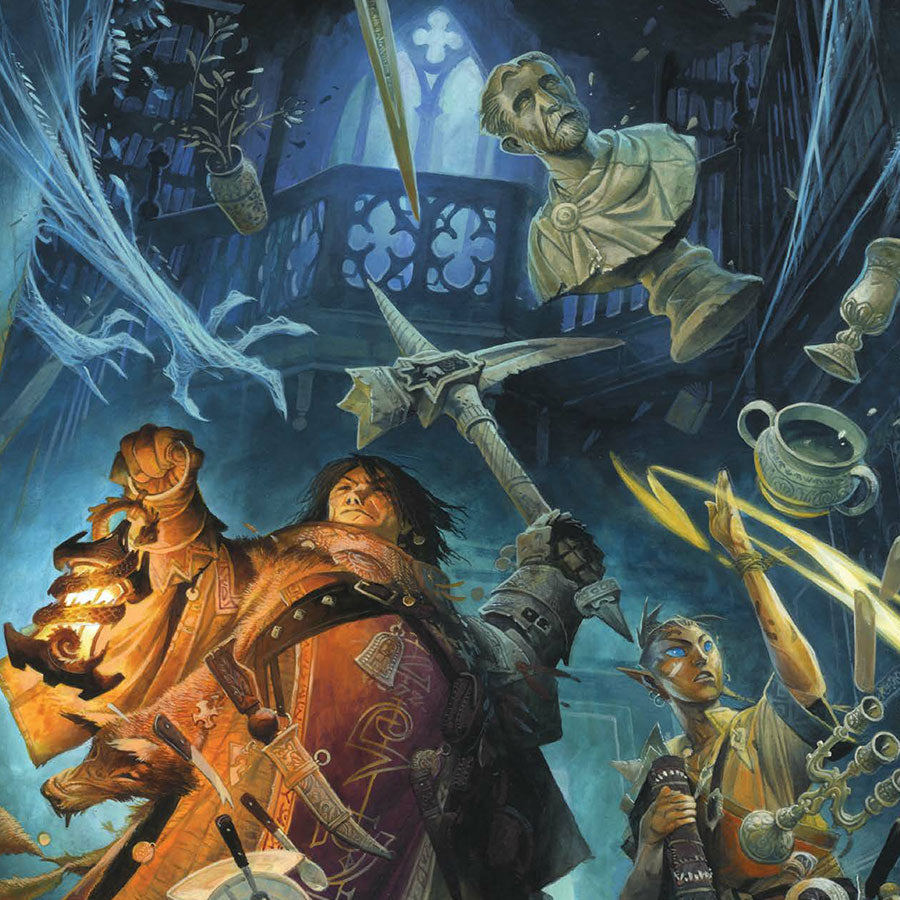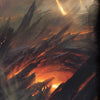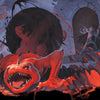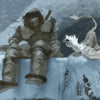10 Pro Tips for Running D&D Traps

Designing an awesome trap for your tabletop RPG can be loads of fun, but have you ever considered how you should RUN THE TRAP at your table? The fact is, the exact same trap can be either amazing or a complete dud, depending on how the game master runs the trap for their D&D, Pathfinder 2e, or TTRPG game.
So, today we walk through 10 pro tips for how a game master can run a trap for their TTRPG to ensure it’s a success and doesn’t completely bomb.
By the way, if you’re a new dungeon master feeling a bit OVERWHELMED by everything involved in running a D&D game, I completely understand. That’s why my team and I made Lairs & Legends.
With over 700 pages of adventures, monsters, puzzles, traps, and other 5e GM resources, Lairs & Legends gives you all the resources you need to remove some of the frustration from being a GM. With this horde of ready-to-use game elements that can be quickly dragged and dropped into your game, you can reduce your prep time and still run amazing games for your players!
Watch or listen to this article by clicking the video below.
#1 Use the Click Rule
This is my number one suggestion for improving traps in D&D. I stole this idea from online somewhere, but don’t remember where I got it. The big problem with normal traps is that when set off they are quite boring. Players make saving throws and then take damage. La de dal. Not fun.
It’s more like a dungeon master screw job, IMO. There’s nothing for the players to really do or engage with. It’s a boring situation that only just results in the DM basically saying “here, take some damage.”
However, there is an easy way to FIX the standard D&D trap without very much work at all, and it involves giving the players choices when the trap goes off.
This is how the click rule works.
When a trap goes off, you describe the triggering even that sets the trap off. This is the “click” part of the rule. For instance, “As you step forward, you feel the floor sink down slightly and a mechanism in the ground begin to rumble. What do you do?”
That’s the “click” where the player has been alerted to the fact they set off a trap. Now the player that set the trap off and all the other players need to quickly tell you what they do. BUT QUICKLY!
If a player doesn’t immediately tell me what they do in response to the trap being set off, they do nothing but stand there like lumps. They’ve been surprised by the trap and can’t react.
Now, I DON’T describe the trap’s effects yet. The players must choose what their characters do first. Then, based on the characters’ actions, I decide if they gain advantage or disadvantage on their saving throw. Or if it’s a straight roll still. Or if perhaps they did something that allowed them to entirely bypass the trap.
Let’s say for this trap a buzz saw comes out of the right-hand wall. A player who drops prone gains advantage on the saving throw. A player who flattens himself against the right-hand wall gains DISADVANTAGE because the buzz saw originates there. The saving throw of a player who dashes forward is unaffected and is a straight roll. A player who is just on the edge of the trap and throws himself backwards out of the area of effect might avoid the trap altogether and not even need to make a saving throw at all.
Then the players are make their saving throws with advantage or whatnot, and I resolve the trap as normal, describing what happens and dealing out damage.
Giving players this quick moment to react to a trap going off and making a MEANINGFUL decision instead of just making a saving throw makes traps way more fun and engaging for players.
#2 Limit the Number of Traps in an Adventure
Traps aren’t the most interesting of things for players to encounter in an adventure, IMO, so I limit the number of traps to one or maybe two in an adventure. Many of my adventures contain no traps at all. I don’t care that they are a classical part of D&D. They often just aren’t much fun.
Then, since there is only maybe ONE trap in an adventure, I can take a little time to flesh it out and make it more interesting and fun for my players. Not just “spikes shoot from the floor; here take some damage!”
I’ll be discussing several ways to spice up traps and make them more engaging for your players in just a little bit.
Finally, unless you’re running an adventure full of creatures known for making lots of traps—such as kobolds—it makes sense not to have too many.
Traps are expensive and time consuming to make in many cases—especially if you consider what are some of the classic D&D traps. So it makes sense that enemies probably only have the resource for maybe one or two traps in their dungeons.
And then when enemies do have traps, they’re going to put them in locations where they get the most bang for their buck. Bottlenecks where intruders MUST pass through the trap to progress further in the dungeon. On chests and doors and other objects they want to guard.
#3 Don’t Use Passive Perception for Spotting Traps
Many dungeon masters allow their players characters to spot traps using their passive perception. That means, as they are walking along, the rogue or ranger or whoever else who happened to pimp out their wisdom and perception so they have a passive perception of 18 or higher is AUTOMATICALLY finding every trap in the dungeon.
Do you see why that’s rather lame right off the bat? Instead of players having to use their brains and decide when to look for traps, they basically have someone who automatically finds them all without any effort whatsoever. Yep, that’s stupid.
In my games, players must DECLARE when they are looking for a trap, and then I call for a Wisdom (Perception) check to look for a trap. I have this same rule for secret doors, by the way.
This makes the game a whole lot more interesting and engaging for players, I feel, when they must be alert to their surroundings AND ACTUALLY LISTEN TO THE DM as they describe an area. Instead of just plowing forward and relying on passive game mechanics to alert them to danger.
Now, if on the perception check the player rolls really horribly, I do allow them to use their passive perception instead. This is my concession to the fact that if I didn’t have this houserule they would have been able to find a trap with their passive perception check.
The classic objection to this houserule of mine is “But Luke, my players will be stopping every two seconds to search for traps!”
I’ve been running fifth edition for nearly 10 years with multiple games a month, and NONE OF MY GROUPS have ever done this. So, I feel like this is a phantom objection.
Once a group of players understand that there are NOT a lot of traps in the game and they either are placed in spots where it’s LOGICAL to have a trap OR they start to learn that the dungeon master’s descriptions will often allude to the presence of a trap—something you should be doing!—then they stop looking for traps after every five feet.
#4 When You Describe an Area, Hint at the Presence of a Trap
The key here is to HINT at it, not give it away completely.
They open a door, you describe the entire room and all that, and somewhere in the description mention that there is the faint odor of sulfur in the air. If players key in on that, they may suspect a trap, and later search the statue in the room to discover it shoots out a gout of flames when a coffer on the fireplace is disturbed. Or player may ignore it and spring the trap. But they may then remember you mentioned the sulfur in the air and be like “we should have known!”
This teaches players to pay attention to your descriptions because they are important and contain clues to the environment and what’s going on. Then players who pay attention and find traps and other things that your flavor texts allude to are REWARDED and feel good for having found those things.
Note: You don’t ALWAYS have to hint at the presence of a trap. Some traps are very well hidden by design. There’s nothing wrong with that either.
#5 Allow Characters to Overcome Traps with Good Ideas Instead of Only Theives’ Tools
Say PCs have found the trap, it’s a 15 foot wide pit with bubbling acid in it. Well how do they get by it? Perhaps thieves tools to manipulate a control box that causes the lid of the pit to close…however there are other options for clever players.
Why not just use a grappling hook on the beam across the ceiling and swing across on a rope?
Flame jets in the corridor? PCs could stuff the holes with rocks or other inflammable material and then make a run for it.
The key to this working is that when the PCs find a trap, you need to describe it in detail so they can brainstorm ways to overcome it.
Trap on a chest. Find a mechanism worked into the hinges with metal bars leading down into a grate on the floor. Removing grate reveals a large bladder that’s part of a mechanism that appears to be designed to squeeze it.
PCs might surmise that the trap causes the bladder to be squeezed, releasing a toxic gas or something. Thus, they decide to break the metal bars that lead from the hinges to the bladder mechanism. This disarms the trap in a way where the players actually have to use their brains instead of just having one of them declare they are making a thieves’ tools check to disarm it.
#6 Make Player Describe How They Disarm Traps
If a player declares they are using thieves tools to disarm a trap, require that they explain HOW they are using the tools to disarm it. Make them use their brains and describe what they are doing.
Very lame for this to happen. DM: “You all find a trap in the room!” Player: “I use thieves’ tools to disarm it.” Makes roll. “17!” DM: “Okay, you’ve disarmed it.”
There was no description of anything. Just a vague “trap”. And then the players simply rolled some dice to overcome it. So lame and boring.
If your traps are like this, dismiss your players now. Spare them the hassle.
Instead, describe a mechanism in the door jam that appears to be attached to the door handle. Then the rogue player is able to describe how they use their thieves' tools to disable the mechanism.
See, it’s not that fancy nor that complicated. However, THIS is roleplaying and makes things more interesting for your players, instead of everything just boiling down to game mechanics.
So, there’s actually TWO parts at work here: the DM must give a decent description of the trap to begin with—not just some vague “you spot a trap!”—and then the player must describe HOW they use their thieves tools to disarm it.
#7 Use Obvious Traps
A trap that goes off, requires a saving throw, and then does full damage or half damage is neither interesting nor fun for the players. But when obvious that there’s a trap; now the players have a fun situation to overcome.
They find a dead burned corpse in the corridor. What happened to it? They look around for traps.
They find a pressure plate and tubes in the walls. Must be a flame jet trap. Then they can figure out a way to overcome the trap. Maybe just leap over. Maybe lie boards over the pressure plate to not trigger it.
That example was fairly simple, but imagine you have a much more complicated trap that requires real thought and creativity to bypass. Could be one of the most fun parts of the game session, basically becoming a puzzle of sorts.
Sometimes these obvious traps have already been sprung. PCs will still investigate and then surmise that something set it off.
This can be used to foreshadow something in the adventure, such as a band of hobgoblins that recently raided the dungeon, setting off traps and fighting its previous occupants. They just never got around to resetting the traps.
#8 Combine Traps with Enemy Encounters
There is nothing quite so horrible as dealing with a trap while also having to fight monsters.
I once created an encounter involving grells and pits. The PCs came into room, and one fell into a pit trap. Then the grells swooped down out of hiding to attack. This kicked the battle off.
The PCs then found MORE pit traps scattered all about the room as they fight the grell…which can fly so they have no issues with the pit traps.
Then players needed to fight the grell being careful where they moved, and every so often someone fell into a pit. It was beautiful.
Another time I created a trap that involved a corridor of blades springing from the walls and cockatrices.
When trapped triggered, buzz saws sprang from the walls at various levels, and several cockatrices were released from a side chamber. The cockatrices were under the level of the blades and not at risk. So, the players had to either take damage from saws while they fought the cockatrices, or drop prone, making it easier for the cockatrices to hit them.
Again, it was an amazingly fun trap and encounter scenario for my players to face off against.
#9 Use Decoys that Hide the True Trap
Sometimes what the players think is the trap is just a decoy intended to make them relax their guard and fall for the true trap.
A pressure plate that is easily found. However, on the other side there is a pit trap so that if a character jumps over the pressure plate—an easy thing to do—they land on the lid of the pit trap and fall in.
Here is a CLASSIC trap from my games, and many of my groups have encountered it.
After one of my groups fought Granny Tichwillow—a reoccurring villain I have in many of my games—they went upstairs and found a chest. The chest has no obvious traps. However, when it was opened, a swarm of wasps came out and attacked. The wasps are easily defeated, though.
Then, in the bottom of the chest, there is a single copper piece. The players think it’s there to mock them. In fact, the players are usually perturbed at having been attacked by wasps only to get one copper piece, and thus one of them reaches in and scoops up the copper piece.
Then electricity surges through him and he’s nailed by a crap ton of electrical damage. That’s the true trap.
Thus, finding a solitary copper piece in places has become a reoccurring joke in some of my groups in response to their finding this trap.
#10 Use Traps that Do More than Just Damage
Why should a trap only result in the PCs taking damage? That’s unimaginative.
Goo falls from the ceiling, trapping them in place, and then biting insects crawl out from the cracks in the walls to swarm over them.
A portcullis falls, trapping them in a room with a hydra. And the portcullis is greased, making it nearly impossible to get out. AND the portcullis split the party!
The point is to use traps for fun and imaginative situations in your games!
Get Loads of 5e Adventures and Resources for Your Games!
When I was a new dungeon master, I was overwhelmed with everything I needed to do. Learn the rules, create the adventures, run the game, handle problem players—it was A LOT! And even as a veteran DM, it’s still a lot. You might even feel that way yourself.
If you’re looking for loads of 5e adventures that you can prep in under 30 minutes, or elements such as traps, puzzles, and encounters that you can drag and drop into your game at moment’s notice, we have you covered!
With Lairs & Legends and Loot & Lore, you’ll get over 700 pages of 5e resources:
- Twenty-nine 5e adventures spanning levels 1 to 15 and designed for groups of 4 to 6 players.
- Over 100 new creatures from CR 0 to CR 24.
- Adventure Ideas
- Encounters with Full-Color and Blackline Digital Maps
- Patrons & Factions
- Magic Items
- NPCs
- Puzzles
- Random Encounter Tables
- Random Tables
- Spells
- Subclasses
- Traps
- Villains
Everything is designed to be EASY TO USE and QUICK TO PREP for your game. Our goal is to make game masters’ lives easier, not more complex!
Don’t spend another moment frustrated and overwhelmed as a DM. Pick up the Lairs & Legends Ultimate Bundle today and find out how much easier being a DM can be!
-
Posted in
Game Master How-To Articles







